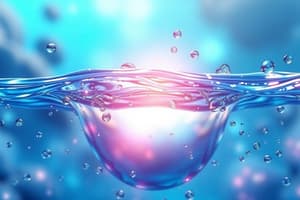Podcast
Questions and Answers
What is the main characteristic of a concentrated solution?
What is the main characteristic of a concentrated solution?
- Is always safe to handle.
- Is the same as a dilute solution.
- Contains a small amount of dissolved solute.
- Contains a large amount of dissolved solute. (correct)
Which of the following safety procedures is crucial when diluting sulfuric acid?
Which of the following safety procedures is crucial when diluting sulfuric acid?
- Add acid to water to minimize reactions. (correct)
- Allow the acid to cool before diluting.
- Use tap water for dilution.
- Add water to the acid for thorough mixing.
What does the formula c = n/V represent in a solution?
What does the formula c = n/V represent in a solution?
- The total weight of the solution.
- The mass of the solute in grams.
- The amount concentration of the solution. (correct)
- The volume of the solvent needed.
What is a standard solution?
What is a standard solution?
How does temperature generally affect the solubility of a solid solute in a liquid?
How does temperature generally affect the solubility of a solid solute in a liquid?
Which action is necessary to ensure precise preparation of a standard solution?
Which action is necessary to ensure precise preparation of a standard solution?
When considering the dilution of a solution, what is a dilution factor?
When considering the dilution of a solution, what is a dilution factor?
What is the resulting concentration when 1.0 L of 12 mol/L hydrochloric acid is diluted to 4.0 L?
What is the resulting concentration when 1.0 L of 12 mol/L hydrochloric acid is diluted to 4.0 L?
Which type of pipette is used for delivering fixed volumes?
Which type of pipette is used for delivering fixed volumes?
What is a potential consequence of hydrogen gas accumulation in a poorly ventilated area?
What is a potential consequence of hydrogen gas accumulation in a poorly ventilated area?
In the dilution calculation formula, what does 'c_d' represent?
In the dilution calculation formula, what does 'c_d' represent?
How does the concentration of hydrogen peroxide affect hair color lifting?
How does the concentration of hydrogen peroxide affect hair color lifting?
What does a 6% W/V hydrogen peroxide solution mean?
What does a 6% W/V hydrogen peroxide solution mean?
What is a major environmental advantage of transporting concentrated chemicals?
What is a major environmental advantage of transporting concentrated chemicals?
Which concentration expression type indicates the mass of solute per mass of solution?
Which concentration expression type indicates the mass of solute per mass of solution?
What characterizes a supersaturated solution?
What characterizes a supersaturated solution?
What factor can influence the extent of color lift when using hydrogen peroxide?
What factor can influence the extent of color lift when using hydrogen peroxide?
How does the solubility of gases typically respond to changes in temperature?
How does the solubility of gases typically respond to changes in temperature?
Which statement is true about a saturated solution?
Which statement is true about a saturated solution?
What practical method can be used to test for saturation in a solution?
What practical method can be used to test for saturation in a solution?
How does thermal pollution affect oxygen levels in aquatic ecosystems?
How does thermal pollution affect oxygen levels in aquatic ecosystems?
When scuba divers ascend too quickly, what phenomenon occurs in their blood?
When scuba divers ascend too quickly, what phenomenon occurs in their blood?
What effect does pressure have on the solubility of gases?
What effect does pressure have on the solubility of gases?
What safety concern is associated with using jumper cables to start a dead car battery?
What safety concern is associated with using jumper cables to start a dead car battery?
Flashcards
Amount Concentration
Amount Concentration
The concentration of a solution expressed in moles of solute per liter of solution (mol/L).
Concentrated Solution
Concentrated Solution
A solution containing a large amount of dissolved solute relative to the solvent.
Dilute Solution
Dilute Solution
A solution containing a small amount of dissolved solute relative to the solvent.
Dilution
Dilution
Signup and view all the flashcards
Stock Solution
Stock Solution
Signup and view all the flashcards
Dilution Process (Acid)
Dilution Process (Acid)
Signup and view all the flashcards
Calculating Concentration
Calculating Concentration
Signup and view all the flashcards
Standard Solution
Standard Solution
Signup and view all the flashcards
What is a saturated solution?
What is a saturated solution?
Signup and view all the flashcards
Unsaturated Solution
Unsaturated Solution
Signup and view all the flashcards
Supersaturated Solution
Supersaturated Solution
Signup and view all the flashcards
Solubility Curve
Solubility Curve
Signup and view all the flashcards
Solubility of Solids and Temperature
Solubility of Solids and Temperature
Signup and view all the flashcards
Solubility of Gases and Temperature
Solubility of Gases and Temperature
Signup and view all the flashcards
Solubility & Pressure (Gases)
Solubility & Pressure (Gases)
Signup and view all the flashcards
Oxygen Solubility & Aquatic Life
Oxygen Solubility & Aquatic Life
Signup and view all the flashcards
Dilution Formula
Dilution Formula
Signup and view all the flashcards
Volumetric vs. Graduated Pipettes
Volumetric vs. Graduated Pipettes
Signup and view all the flashcards
Hydrogen Peroxide's Role in Hair Dye
Hydrogen Peroxide's Role in Hair Dye
Signup and view all the flashcards
Volume/Volume (% V/V)
Volume/Volume (% V/V)
Signup and view all the flashcards
Weight/Volume (% W/V)
Weight/Volume (% W/V)
Signup and view all the flashcards
Weight/Weight (% W/W)
Weight/Weight (% W/W)
Signup and view all the flashcards
Study Notes
Water and Its Properties
- Most compounds with similar molecular mass to water (e.g., methane) are gases at room temperature due to weak intermolecular forces.
- Water is a liquid at room temperature because its intermolecular forces are unusually strong, particularly hydrogen bonding.
- Methane has a central carbon atom bonded to four hydrogen atoms. The symmetrical arrangement makes methane non-polar. Intermolecular forces are London dispersion forces, which are weak.
- Hydrogen chloride (HCl) has a polar covalent bond due to chlorine's higher electronegativity than hydrogen. Intermolecular forces include London dispersion forces and dipole-dipole forces.
- Water molecules are highly polar due to the polarity of the H-O bonds and their asymmetrical arrangement. Hydrogen bonding occurs between hydrogen in one water molecule and oxygen in another.
- Hydrogen bonding is a significant type of intermolecular force giving water unique properties.
Significance of Hydrogen Bonding
- Hydrogen bonding contributes to many unique water properties vital for life on Earth.
- Water stays liquid at room temperature because of hydrogen bonding.
- Water has high melting and boiling points due to hydrogen bonding.
- Water's ability to absorb/release large amounts of thermal energy moderates temperature changes in organisms and the environment.
- Water's inability to mix with non-polar compounds allows organisms to retain water and store non-polar substances.
- Water expands when freezing, causing ice to float, which enables life to survive in bodies of water.
Solutions
- A solution is a homogeneous mixture with a uniform composition throughout (one phase).
- Solutions can be solids, liquids or gases.
- Solutions appear transparent because the entities they contain are too small to block light.
- Solutions can be coloured or colourless.
- A glucose solution (IV drip) is an example of a solution where glucose (solute) dissolves in water (solvent).
- Homogeneous mixtures are uniform throughout. Heterogeneous mixtures have distinct phases. (e.g., oil and vinegar)
Components of a Solution
- Concentration: the ratio of solute/solution or solvent.
- Concentrated solution: a solution with a relatively large quantity of solute.
- Dilute solution : a solution with a relatively small quantity of solute.
- Aqueous solutions: contain water as the solvent. (Most solutions in investigations are aqueous).
Aqueous Solutions
- They are transparent.
- Used in many common products (e.g., pop, vinegar, shampoo).
Decompression Sickness
- Scuba divers risk gas bubbles forming in their blood if ascending too quickly.
Water Contaminants
- Physical contaminants: debris and suspended particles.
- Biological contaminants: bacteria, viruses, and protozoa.
- Chemical contaminants: water-soluble substances (e.g., heavy metals, organic solvents).
Water Quality Standards
- Health Canada sets guidelines for acceptable contaminant levels in drinking water.
- Provincial/territorial governments implement testing programs.
Water Treatment Process
- These processes involve removing contaminants.
- Steps include collection, treatment, disinfection, purification, and softening (reducing mineral content)
Chemical Analysis Types
- Qualitative analysis identifies substances.
- Quantitative analysis measures concentrations of substances (e.g., X-ray diffraction).
Precipitation Reactions
- Certain ions can be identified by the differences in solubility. (e.g., lead ions forming yellow PbI₂ precipitate).
Spectroscopy
- An advanced method used to analyze light emissions to determine qualitative/quantitative data.
Dilution
-
Dilution involves adding solvent to a concentrated solution to decrease its concentration.
-
The formula for dilution is c₁V₁ = c₂V₂ where c₁ and V₁ are the initial concentration and volume and c₂ and V₂ are the final concentration and volume of the solution.
Hydrogen Peroxide in Hair
- Used to lighten hair color through a process called "lifting."
- Higher concentrations can lift color faster but may cause more damage.
- Concentration expressions include V/V, W/V, and W/W.
Studying That Suits You
Use AI to generate personalized quizzes and flashcards to suit your learning preferences.




